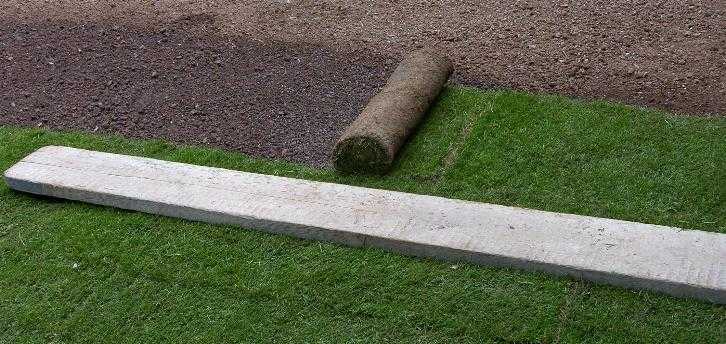Turf Laying Advice
Where to start turf laying
Before you can lay your new lawn you will need to prepare the ground, take your time here and laying your turf laying will be quick and easy.
Removing the rubbish
Your first step will be to remove any long grass and weeds, a strimmer is best for this, remember to always wear goggles and gloves when using any equipment. Try not to use a weedkiller unless it is really essential, using them will generally delay being able to lay your turf for a while.
If you are renewing an existing lawn you may wish to remove the old lawn, however this is a lot of hard work and provided the ground is dug or rotovated well you can remove any clods of the existing lawn when you are levelling.
Digging or rotovating
Next you will need to dig or rotovate the ground, for very large areas it will be best to hire a rotavator or cultivator, for smaller areas if you are feeling fit you can dig the area by hand.
When rotovating run the machine along the longest length up and down, and when this is done run along the ends, generally it pays to go over the area at least twice, until you have a fine tilth.
When digging the area, dig to a depth of about 6-8 inches, be sure to turn the earth over, trampling the ground will generally break down any large clods, and remove any large stones or rubbish as you go.
If you can, allow the ground to settle for a few days before turf laying.
Levelling
The next step is to level the ground, for this you will need a rake and some string for your lines, start by running a string line for any borders, put this line at the level you want your lawn to be, alternatively use the bottom of fence panels as a guide for your level. If you are joining up to an existing lawn start at the joining point if not start from a corner of the area, with your rake work your way across the area leaving a smooth level finish with no humps or bumps, be sure to remove any large stones, weeds and any lumps of grass from the existing lawn.
Rolling
You can roll the ground if you wish, but you will have to re-level it afterwards, it is not essential however as you will firm the ground when laying your turf.

Laying your freshly cut colchester turf
Once all this is done you are ready to start turf laying, for this you will need some boards (scaffold boards are best) and a sharp knife.
Start by laying your first line of turf, (a little tip is to lay the turf in the same direction as you will look at it from a window etc, not across it, this reduces the amount of joints you have to look at for a few days).
Once your first line is laid lay your boards on top of it. Walk on the boards when you lay your next line, this helps to level and firm the ground, remember to stagger the joints on each line (like brickwork), and to but the turf up tight together with no gap but not overlapping them. Use your knife to cut your turf to the correct length. Work across the ground always turning over your boards and walking on them to lay your next line. (another tip is to lay one line up along the line and the next line down this will give your new lawn a striped effect, however this will only last a few days).
Try not to walk on the turf you have laid unless you use a board, as doing so will cause hollows in the lawn. When you get to the end you will probably end with a small strip to cut, in dry weather it is best not to put small strips on the edge of a lawn, they dry out quicker on the outside, put a whole turf on the edge and the cut in from that as shown.
If you would prefer to have us to carry out your turf laying please contact us on 01206 822649
Aftercare of your colchester lawnturf
Looking after your new lawn
When your lawn is laid it is very important to keep off of it for 2-3 weeks to allow it to settle. If it is dry you will need to water the lawn daily, it will need a good soaking, as the lawn starts to root you can give it less water, It is very easy to underwater it and this is a common problem, lift the corner of a turf and check that the turf and ground it is on are wet, buy yourself a good sprinkler you can tell if it is short of water the grass will start to loose it’s glossy appearance.
Mowing your new lawn
When you can walk on your new lawn without leaving any impression and you can grab hold of a corner of turf and it will not easily come up you can give your lawn its first mow, if possible raise the mower for the first few cuts, regular mowing is the key to a good lawn.
Maintaining your new lawn
Once you lawn is established, to keep it looking nice you should feed it, this should be done at least once a year preferably twice, if you are going to feed once the best time is in the spring, if feeding twice it should be spring and autumn, your local garden centre should stock these, make sure you apply them at the manufacturers specified application rate.